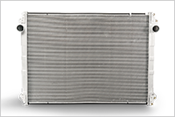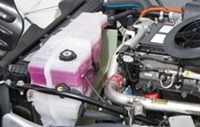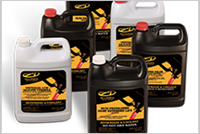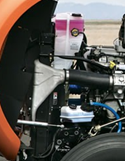 With the hottest months of the year bearing down upon us, is your engine is set to take a beating from the heat? As important as air conditioning is to keeping us cool in our cabs, so too is the importance of a properly maintained cooling system in your engine, if not more so. Without this important system cooling properly, your engine’s metal parts would try to fuse together under the extremely hot conditions of everyday operation.
With the hottest months of the year bearing down upon us, is your engine is set to take a beating from the heat? As important as air conditioning is to keeping us cool in our cabs, so too is the importance of a properly maintained cooling system in your engine, if not more so. Without this important system cooling properly, your engine’s metal parts would try to fuse together under the extremely hot conditions of everyday operation.
 As I pulled out with a few friends last week for the start of our workweek, I saw a friend of mine filling an empty water jug at the water spigot. Always one to look out for a good friend, I pulled over to see if he and his truck were alright. He let me know that he had a slow coolant leak that he was planning to get fixed, but needed to top off every three days or so. I asked him if he had any idea what coolant he had and upon further investigation, I found out he had red colored coolant that was either an extended life coolant (ELC) or ethylene glycol coolant (EG). It was then that I cautioned him against using water to top off his coolant tank, as it could do several things to hurt his engine.
As I pulled out with a few friends last week for the start of our workweek, I saw a friend of mine filling an empty water jug at the water spigot. Always one to look out for a good friend, I pulled over to see if he and his truck were alright. He let me know that he had a slow coolant leak that he was planning to get fixed, but needed to top off every three days or so. I asked him if he had any idea what coolant he had and upon further investigation, I found out he had red colored coolant that was either an extended life coolant (ELC) or ethylene glycol coolant (EG). It was then that I cautioned him against using water to top off his coolant tank, as it could do several things to hurt his engine.
 In most cooling systems, exact specifications have been engineered into the coolant itself to do much more than just cool the engine and protect against freezing. There are optimum levels of pH acidity, anti-corrosion, anti-freezing and cooling chemicals built into all brands of coolants. These exact mixtures far surpass the cooling and anti-freeze power of plain water alone, as water tends to boil, freeze, evaporate, and corrode under an engine’s extreme operating conditions. Adding water to specifically designed coolants that are already at these desired levels (ELC’s and EG’s alike) will not only dilute their cooling properties, but will also add other chemicals that can hurt your engine and cooling system. Remember, the chemicals in the water don’t magically disappear once mixed in and can lead to premature corrosion and build up from inside! Things exist in tap water including salt, calcium and chlorine to name a fewthat can do more damage than good.
In most cooling systems, exact specifications have been engineered into the coolant itself to do much more than just cool the engine and protect against freezing. There are optimum levels of pH acidity, anti-corrosion, anti-freezing and cooling chemicals built into all brands of coolants. These exact mixtures far surpass the cooling and anti-freeze power of plain water alone, as water tends to boil, freeze, evaporate, and corrode under an engine’s extreme operating conditions. Adding water to specifically designed coolants that are already at these desired levels (ELC’s and EG’s alike) will not only dilute their cooling properties, but will also add other chemicals that can hurt your engine and cooling system. Remember, the chemicals in the water don’t magically disappear once mixed in and can lead to premature corrosion and build up from inside! Things exist in tap water including salt, calcium and chlorine to name a fewthat can do more damage than good.
Upon receiving my advice, this friend of mine decided to go down to the company terminal with this newfound wisdom and pick up the matching red coolant to top off the reservoir instead of using water. Needless to say, I was glad to have educated him on the harmful effects of water in his engine’s cooling  system and prevent him from making this harmful common mistake. Be sure to check for leaks, maintain proper fill levels, and maintain a proper chemical balance in your cooling system. Having your coolant tested is fairly inexpensive and can usually be done when your truck is in for an oil change or other basic service. This can help insure that you have the proper balance of chemicals and proper pH acidity for optimum performance. Many of us have oil analysis done to help prevent minor problems from turning into major ones, but many more tend to overlook the similar importance of coolant tests as well!
system and prevent him from making this harmful common mistake. Be sure to check for leaks, maintain proper fill levels, and maintain a proper chemical balance in your cooling system. Having your coolant tested is fairly inexpensive and can usually be done when your truck is in for an oil change or other basic service. This can help insure that you have the proper balance of chemicals and proper pH acidity for optimum performance. Many of us have oil analysis done to help prevent minor problems from turning into major ones, but many more tend to overlook the similar importance of coolant tests as well!